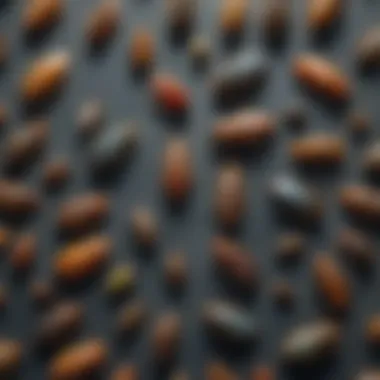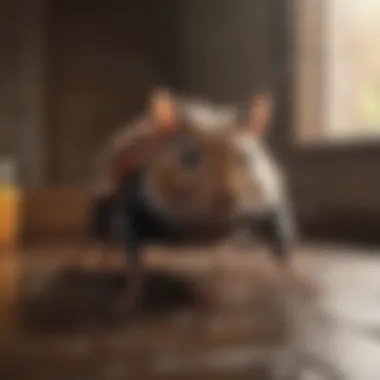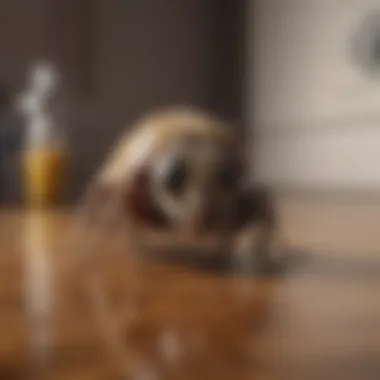Arest a Pest: Insights into Household Pest Management


Intro
Household pests can turn a serene living space into a stressful environment. They not only pose risks to hygiene but can also damage property. Understanding the nature of these invaders is essential for effective management. This article aims to unfold strategies and approaches to tackle pest issues holistically—from preventing infestations to implementing control measures.
Preventive Pest Control Strategies
Pest management starts long before an infestation becomes apparent. A proactive approach can significantly reduce risks. Here are some essential strategies that homeowners should adopt.
House Exterior Protection
Sealing the exterior of your house is a fundamental step in keeping pests out.
- Tips for sealing cracks: Use caulking compounds to seal gaps around windows, doors, and foundations.
- Clearing debris: Regularly remove debris from around the home. Wood piles, leaves, and mulch create havens for pests.
- Preventing pests from entering: Install door sweeps and use screens on windows. This blocks entry points for pests like ants and spiders.
Yard Maintenance
Maintaining your yard is crucial to deter pests.
- Essential yard care routines: Regularly trim bushes and mow the lawn. This keeps the area tidy and discourages pest habitats.
- Methods for keeping yard pest-free: Use organic pest control options on plants. Neem oil and diatomaceous earth can be effective against common garden pests.
Indoor Cleanliness
A clean home is less attractive to pests.
- Expert cleaning tips and techniques: Regularly vacuum and wipe surfaces. Focus on areas that often get neglected, such as under appliances.
- Maintaining a pest-resistant indoor environment: Store food in airtight containers and do not leave crumbs behind. This makes it difficult for pests to find food sources.
Garbage Disposal
Proper waste management can deter various pests.
- Efficient waste disposal methods: Use sealed garbage bins. Make sure to take out trash regularly, especially items that attract pests.
- Importance of proper garbage disposal: Pests are drawn to food odors. Keeping your waste contained can diminish these attractions.
Other Pest Prevention Strategies
Think outside the box for additional layers of protection.
- Innovative ways to safeguard your home: Consider planting pest-repellent plants such as marigolds and lavender around your yard.
- Implement predator presence: Birds like sparrows can help manage insect populations, adding a natural layer of control to your space.
Identifying Pest Risk Areas
Identifying where pests are likely to thrive is just as critical as proactive measures.
Moisture Prone Areas Inspection
Pests are often attracted to damp environments.
- Identifying damp conditions: Check basements, bathrooms, and kitchens for leaks.
- Tips for preventing infestations: Use dehumidifiers and ensure good ventilation. Keeping moisture levels low is key.
Crack and Crevice Inspection Guide
Small openings can be major entry points for pests.
- Importance of inspecting access points: Regularly check for cracks in walls, around pipes, and near doors.
- Strategies for sealing cracks and crevices: Use expanding foam or mesh to close off these potential passages.
Greenery Inspection for Pest Risks
Overgrown plants can conceal pest nests.
- Understanding greenery's impact on pests: Dense shrubs and trees offer shelter for pests.
- Guidelines to maintain pest-free yards: Trim foliage regularly and avoid planting too close to the home.
Additional Pest Risk Areas
Sometimes, risks can appear in unexpected places.
- Miscellaneous pest risk areas and preventive measures: Check garages, attics, and crawl spaces regularly for signs of pests.
Effective Pest Control Methods
When prevention isn't enough, knowing how to respond effectively is essential.
Natural Repellents for Pest Control
Chemical-free options can be quite effective.
- Safe and effective natural solutions: Use essential oils like peppermint or lavender as repellents.
- Use of essential oils, herbs, and plants: Peppermint oil can deter ants, while basil may repel flies.
Chemical Sprays for Pest Control
Sometimes, stronger measures are necessary.
- Safe usage of professional sprays: When using chemical sprays, follow instructions carefully.
- Eradicating pests with chemical solutions: Applications targeting specific pests can provide immediate relief and can be highly effective.
Pest Traps: Effective Pest Control Solutions
Traps can provide a method of capturing instead of killing pests.
- Setting up and using pest traps: Place traps near suspected entry points. Ensure they are regularly checked.
- Capturing and removing pests safely: Release captured pests far from homes, reducing the chance of return.
Biological Control Methods for Pest Prevention
Using nature to your advantage is an eco-friendly approach.
- Using natural predators for pest management: Ladybugs can manage aphid populations effectively.
- Environmental-friendly pest control techniques: Promoting biodiversity can help keep pest populations in check.


Other Pest Control Methods
Since pest management is not one-size-fits-all, it’s worth exploring diverse methods.
- Innovative pest control methods beyond traditional options: Consider using ultrasonic pest repellents, which emit high-frequency sounds to deter rodents.
By identifying pest risk areas and maintaining proactive measures, homeowners can create a sustainable environment where pests are less likely to thrive.
Identifying and managing household pests is an ongoing task. This article highlights critical strategies to ensure your home remains a comfortable haven.
Defining Household Pests
Understanding household pests is crucial for effective management. By defining what constitutes a pest, homeowners can better identify issues early and mitigate potential damage. This knowledge allows for informed decision-making regarding prevention and control strategies.
Household pests are typically organisms that have a negative impact on human living spaces. They can cause damage to property, contaminate food, and even pose health risks. Recognizing the specific characteristics of these pests helps in developing targeted approaches to their management.
In this section, we will explore the defining traits that categorize certain species as pests. Additionally, we will discuss the common types of pests found in homes, thus establishing a clear framework for understanding potential threats to both health and property.
Characteristics of Pests
Pests possess specific characteristics that set them apart from non-pest species. One major feature is their ability to reproduce rapidly, allowing for quick infestations. Many pests, such as rodents or insects, have short life cycles and can produce large numbers of offspring.
Another characteristic is their adaptability. Most pests can thrive in a variety of environments and often develop resistance to commonly used deterrents or chemicals over time. This resilience makes them particularly troublesome for homeowners.
Pests tend to exhibit behaviors that directly affect human environments. For example, they often seek shelter in human habitats for warmth, food, and security. Understanding these characteristics allows homeowners to anticipate pest behavior and take proactive measures.
Common Types of Pests
Rodents
Rodents are one of the most common household pests. They include species like the house mouse and the Norway rat. They are known for their high reproductive rate and voracious appetites. This makes them a significant concern for homeowners. Their ability to squeeze through tiny openings allows them to invade almost any space.
The risk of property damage is high since rodents can chew through wires, insulation, and even structural elements. Their droppings can contaminate food sources, posing health risks.
Insects
Insects comprise a vast category of pests, including ants, cockroaches, and bedbugs. These creatures often invade homes seeking food and water. Ants, for example, are known for their organized colonies and can quickly establish trails to food sources.
Insects can be particularly resilient, as some can survive in extreme conditions. Certain types can develop resistance to insecticides, complicating control measures. Additionally, many insects can transmit diseases to humans, further emphasizing the need for effective management strategies.
Termites
Termites are often referred to as "silent destroyers" due to their ability to cause significant structural damage without immediate detection. They feed primarily on wood, and their presence can go unnoticed until substantial damage has occurred.
Termites live in colonies that can number in the thousands, making them formidable when populations grow near a home. Their chewing can weaken homes and lead to costly repairs. Awareness of termite behavior is essential for early detection and prevention.
Outdoor Pests
Outdoor pests, such as mosquitoes and ticks, are also of concern since they can intrude upon living spaces. Mosquitoes, for instance, thrive in damp areas and can transmit serious diseases, including West Nile virus or Zika virus.
Additionally, ticks can attach to pets or humans, carrying diseases like Lyme disease. Understanding the behaviors of these outdoor pests can help in developing strategies to manage both indoor and outdoor pest control effectively.
It is essential for homeowners to recognize these pests early to mitigate damage and protect their health.
In summary, defining household pests requires understanding their characteristics and the common types that may invade your space. This knowledge serves as a foundational step toward effective pest management.
The Impact of Pests on Health
Understanding the impact of pests on health is crucial for homeowners. Household pests can lead to various health issues. These problems range from allergies caused by pest droppings to severe illnesses from diseases transmitted by vectors such as rodents and insects. Therefore, gaining insight into the health risks associated with pest infestations can promote better preventive measures for households.
Health Risks Associated with Infestations
Allergies
Allergies related to household pests are a common issue. Pests like dust mites, cockroaches, and rodents can trigger allergic reactions. These reactions may include sneezing, itching, and even asthma exacerbations. Rodents leave behind droppings that contain allergens, which can become airborne. Reducing allergens contributes to creating a healthier living space. It’s also beneficial for those with pre-existing respiratory conditions.
Disease Transmission
Diseases transmitted through pests represent a significant risk. Rodents and insects can carry dangerous pathogens. Diseases like hantavirus, Lyme disease, and salmonellosis can originate from pest infestations. The key characteristic of disease transmission is its unpredictability. Homeowners must be vigilant in monitoring for signs of pests and implementing preventative measures. The presence of these pests creates an environment conducive to health risks.
Psychological Stress
Pest infestations can lead to psychological stress. The knowledge of pests invading one's living space can result in anxiety and sleeplessness. This is often underestimated in relation to physical health impacts. The constant worry about the potential for pest-related damage to homes or health is draining. Addressing this aspect helps in promoting comprehensive well-being for homeowners.
Signs of Potential Infestations
Recognizing signs of infestations early is essential in managing pests effectively. Homeowners need to stay attentive to certain indicators that suggest the presence of pests.
Visual Indicators
Visual indicators are often the first clue to an infestation. This includes unusual marks on walls, droppings, or even the pests themselves. Inspection for any signs of gnawing or nests can reveal the pests’ presence. Early detection can significantly reduce the extent of an infestation, which is crucial for effective control.
Unusual Noises
Unusual noises often signal the presence of hidden pests. Sounds such as scratching or scurrying in walls or ceilings typically indicate rodents. Paying attention to these subtle cues can prompt timely interventions. Ignoring these sounds may lead to severe infestations and subsequent health risks.
Odors
Odors from pests often inform homeowners about infestation. A musty smell may indicate a rodent problem, while a strong odor could suggest a larger pest presence, such as decaying insects. Detecting and addressing bad odors promptly can help maintain a healthy home environment. Homeowners should regularly check for any strange smells during routine inspections.
Understanding Pest Behavior
Understanding pest behavior is crucial for effectively managing infestations in your home. Knowing how pests reproduce, where they prefer to live, and their daily activities can help homeowners take proactive measures to prevent infestations and to address them swiftly when they occur.


One significant benefit of studying pest behavior is the ability to anticipate and counteract their actions before they lead to damage or health risks. Each pest species has distinct habits and preferences that dictate their behavior, impacting how and when they invade homes. By understanding these elements, you can implement targeted strategies that align with the specific characteristics of each pest.
For example, many insects and rodents have specific reproductive patterns, meaning that a small problem can escalate quickly if not addressed. Similarly, recognizing habitat preferences allows for better preventive measures.
In essence, understanding pest behavior is not just about reacting to infestations; it is about foreseeing threats and acting accordingly to maintain a pest-free environment.
Reproductive Patterns
The reproductive patterns of pests are one of the most critical aspects to monitor. Many common pests reproduce at alarming rates. For instance, female mice can give birth to up to ten young every three weeks. This rapid reproduction can lead to overwhelming infestations if the initial signs are not caught early.
Common reproductive behaviors you should be aware of include:
- Mating Seasons: Certain pests have specific seasons during which they breed most actively. Understanding these times allows for timely intervention before populations increase dramatically.
- Nest Building: Many pests, like ants and termites, will build nests close to food sources. Identifying nesting sites can help in taking preventive action early.
- Larval Stages: Insects like cockroaches go through egg and larval stages before becoming adults. Recognizing these stages can help in identifying and treating infestations sooner.
"Recognizing the reproductive patterns of pests is essential to nip infestations in the bud before they can grow significantly."
Overall, by understanding how pests reproduce, proactive measures can be taken to control populations before they become unmanageable.
Habitat Preferences
Pests often have specific habitat preferences that dictate where they thrive. Understanding these preferences can dramatically improve your pest management strategies. For example, cockroaches prefer warm, humid environments like kitchens or bathrooms, while rodents often make their homes in attics or basements where they are safe from predators.
To effectively manage pests, consider these elements of habitat preferences:
- Moisture Sources: Many pests are attracted to moisture. Fixing leaks and reducing humidity can make your home less appealing.
- Food Availability: Pests are usually drawn to areas with easy access to food. Store food in sealed containers and clean up spills promptly.
- Shelter and Hiding Places: Cardboard boxes, clutter, and cracks in walls provide pests with hiding spaces. Reducing clutter and sealing entry points helps deter them.
By recognizing the habitat preferences of potential pests, you can take steps to minimize their attractiveness to your home, thereby reducing the risk of infestations.
Effective Pest Prevention Strategies
Effective pest prevention strategies are essential for maintaining a safe and healthy living environment. By understanding how to prevent pests from entering and thriving in the home, homeowners can save themselves from health issues, property damage, and the associated costs of pest control. This section focuses on specific sanitation practices and home maintenance that can significantly reduce the likelihood of infestations.
Sanitation Practices
Sanitation practices lay the foundation for effective pest prevention. By keeping the living space clean and conducive to health, any potential pest attraction can be minimized.
Proper Waste Management
Proper waste management involves more than just taking out the trash. It includes regular disposal of waste, using sealed containers, and maintaining cleanliness around waste disposal areas. This method contributes directly to reducing pest presence, as improper disposal can attract rodents and insects. One key characteristic of proper waste management is the use of bins with tight-fitting lids, preventing odors and access to food scraps. By ensuring garbage is kept out of reach, pests are less likely to take up residence.
- Keeping waste sealed and managed is a simple yet effective strategy to discourage pests.
The unique feature of this practice is the proactive approach it encourages. Regularly emptying and cleaning bins prevents any buildup of waste that can act as a food source. While it seems straightforward, neglecting this can lead to significant pest issues, making proper waste management a beneficial choice in any pest prevention strategy.
Food Storage Techniques
Food storage techniques play a critical role in pest control. Ensuring that food is stored properly can thwart potential infestations at their source. One key characteristic of effective food storage is using airtight containers to keep food safe from pests. This simple practice reduces the accessibility of food sources for insects and rodents.
Proper labeling and organization can also help in minimizing waste and keeping track of food expiry. Unique features of these methods include easy access to food while ensuring it remains pest-proof.
However, if food is not stored correctly, it can lead to severe infestations that are difficult to manage, illustrating why these techniques are essential in maintaining a pest-free environment.
Home Maintenance and Repairs
Home maintenance and repairs must not be overlooked when preventing pest infestations. Simple modifications and regular upkeep can mitigate the risk of pest invasions.
Sealing Entry Points
Sealing entry points is a fundamental aspect of pest prevention. This process involves checking for gaps, cracks, or holes in the structure of the home and addressing them immediately. It helps to prevent pests from entering, contributing to an overall goal of maintaining a pest-free home. A vital characteristic here is utilizing caulk or other sealants to fill small openings, which is effective in blocking potential entry routes.
The unique feature of sealing entry points is its long-term impact. Once sealed, these points can deter pests persistently, making it a crucial strategy for anyone keen on effective pest management.
Regular Inspections
Regular inspections enable homeowners to identify and address pest vulnerabilities promptly. By routinely checking home areas, such as basements, attics, and around windows, issues can be recognized before they develop into serious infestations. One key characteristic of these inspections is the systematic approach to examining common problem areas.
Conducting thorough inspections provides the opportunity to discover early signs of pest activity, allowing for intervention before a larger problem arises. While it requires time and diligence, the peace of mind it brings is often worth the effort.
Approaches to Pest Control
In managing household pests, understanding various approaches to pest control is fundamental. This section focuses on the strategies used to keep unwanted creatures at bay. A well-organized pest control plan should consider effectiveness, safety, and environmental impact.
Chemical Control Methods
Chemical methods often come to mind when thinking about pest control. They are widely used due to their quick results and ability to eliminate pests effectively. However, it is crucial to understand the types available and the precautions necessary when using them.
Types of Pesticides
Pesticides can be classified into several categories such as insecticides, rodenticides, and fungicides. Each type serves a specific purpose. For instance, insecticides target insects specifically, which makes them an effective choice for many pest-related issues. The key characteristic of insecticides is their ability to disrupt the biological processes of pests, leading to their elimination.
- Advantages: Fast-acting and can be applied easily in various forms such as sprays or granules.
- Disadvantages: Potential harm to non-target species, including humans and pets, if not used correctly.
Safety Precautions
Safety precautions are essential when handling pesticides. These products can often be hazardous and require careful attention. The key characteristic of safety protocols is to minimize risk to both the user and the environment.
- Wear protective gear: This includes gloves, masks, and goggles to prevent exposure.
- Proper storage: Keep pesticides in their original containers and out of reach of children and pets.
Proper handling of chemicals ensures not only effective pest control but also the safety of household members and pets.
Biological Control Measures


Biological control measures draw on nature to manage pest populations. This method promotes the use of naturally occurring predators or other biological agents. This approach is gaining popularity as a more sustainable and eco-friendly option.
Naturally Occurring Predators
Naturally occurring predators such as ladybugs and certain birds can significantly reduce pest populations. Introducing these predators can lead to a balance in the ecosystem. Their key characteristic lies in their ability to target specific pests without harmful side effects on the environment.
- Advantages: Eco-friendly and sustainable; they do not pose health risks to humans or pets.
- Disadvantages: They may not always completely eliminate pests and can take time to establish.
Viral and Bacterial Solutions
Another branch of biological control involves viruses and bacteria that specifically target pests. These solutions utilize microorganisms to reduce pest numbers. The key feature of viral and bacterial solutions is their specificity, meaning they do not harm other organisms.
- Advantages: Targeted action reduces the chance of affecting non-target species.
- Disadvantages: May require specialized knowledge for effective application and might take longer to see results compared to chemical methods.
Integrated Pest Management (IPM)
IPM is a holistic approach that combines various control methods. This strategy focuses on long-term prevention and relies on monitoring pest activity.
Combining Methods
Combining chemical, biological, and cultural methods is one of the best practices in pest management. This key characteristic of IPM allows flexibility and adaptability to the specific pest situation in one's home.
- Advantages: Provides a comprehensive solution that can be more effective over time.
- Disadvantages: Requires ongoing attention and adjustment based on monitoring results.
Monitoring and Assessment
Monitoring and assessment are integral to IPM. By keeping track of pest activity, you can make informed decisions on treatment methods. This key characteristic fosters an understanding of pest behaviors and patterns.
- Advantages: Helps in identifying the most effective combination of strategies, potentially saving time and resources.
- Disadvantages: Can be time-consuming and requires a certain level of expertise to assess the situation correctly.
Legal and Ethical Considerations
Understanding the legal and ethical considerations in pest management is crucial for homeowners. These aspects shape how we approach pest control while ensuring safety for both humans and the environment. A well-informed strategy encompasses compliance with regulations and adherence to ethical practices. This not only protects public health but also reflects responsible stewardship of the environment.
Regulations on Pest Control Products
Regulations around pest control products are established to protect public health and the environment. In many countries, regulatory bodies like the Environmental Protection Agency (EPA) oversee the safety of pesticides. These regulations dictate what substances can be used and under what circumstances.
For homeowners, understanding these regulations is important. It ensures that the products they choose are effective and safe. Non-compliance can lead to legal repercussions, health risks, and environmental damage.
Key regulations often include:
- Approval of substances: All pest control products must go through rigorous testing before they can be marketed.
- Labeling requirements: Labels must clearly state ingredients, application instructions, and safety precautions.
- Prohibitions: Certain harmful chemicals may be banned.
Choosing compliant and properly labeled products fosters an eco-friendly pest management approach.
Ethics of Wildlife Control
The ethics surrounding wildlife control focus on how we manage and interact with nature. Responsible pest management must balance effectiveness with humane treatment of animals. The ethical treatment of wildlife offers long-term benefits to ecosystems and human society.
Humane Treatment
Humane treatment in pest control emphasizes minimizing suffering. This approach seeks to capture or remove pests without causing harm. It contributes to the overall goal of maintaining balance in our ecosystems.
Key characteristic of humane treatment includes:
- Non-lethal methods: Traps and barriers that prevent harm to pests.
- Release protocols: Guidelines for the safe relocation of captured wildlife.
The unique feature of this method is its effectiveness in maintaining pest populations without extermination. A beneficial aspect is the positive public perception it generates. However, some disadvantages may surface in terms of feasibility and cost.
Environmental Impact
The environmental impact of pest management practices is an essential consideration. Ethical pest control must consider how actions affect wildlife habitats and biodiversity. Adopting environmentally conscious methods helps preserve ecosystems.
The key characteristic of a lower environmental impact is the reduction of chemical usage. This approach is regarded as essential for sustainable living. Moreover, a unique feature is the emphasis on natural pest management solutions, which often enhance biodiversity.
While these strategies offer numerous advantages, such as promoting healthier environments, challenges include potential effectiveness and the need for ongoing maintenance and education.
The Future of Pest Management
Pest management is at a crucial point in its development. As urbanization increases and environmental concerns grow, effective management strategies must evolve. Understanding the future of pest management means recognizing the integration of technology and sustainability. This approach benefits both homeowners and the environment. Predictions suggest a shift towards more proactive measures. These include the usage of smarter traps and innovative data analytics.
Technological Advances
Smart Traps
Smart traps are one of the prominent technological innovations in pest control. Their main contribution lies in effectiveness and efficiency. These devices are designed to capture pests with minimal human intervention. A key characteristic of smart traps is their real-time monitoring capability. This allows for prompt responses to infestations before they escalate.
One unique feature of smart traps is their networking ability. They can connect to mobile apps, providing instant alerts about captured pests. This connection enhances user experience and facilitates quicker reactions. The advantageous aspect of smart traps is that they reduce the need for harmful chemicals, making them a popular choice. However, the initial cost can be a disadvantage for some homeowners, potentially limiting adoption.
Data Analytics in Pest Control
Data analytics is transforming how pest control companies operate. By analyzing infestation patterns, pest management professionals can formulate effective strategies. This aspect of pest control allows for targeted interventions rather than a blanket approach. A key characteristic of data analytics in pest control is predictive analysis. This means anticipating pest behaviors based on historical data.
A unique feature of data analytics is the ability to collect extensive data from various sources. This information can include weather patterns and residential data. The benefits include customized pest management plans, which can lead to increased effectiveness. Some disadvantages might be the requirement for technical expertise, which could pose a barrier for smaller pest control firms.
Sustainability Trends
Organic Solutions
The focus on organic solutions is becoming more significant in pest management. This reflects growing concerns over chemical usage and its impact on health and the environment. Organic solutions emphasize natural products as alternatives to synthetic chemicals. A distinctive aspect of these methods is their safety for both humans and pets.
Organic solutions offer substantial benefits, including reduced toxicity and environmental impact. However, the challenge comes in their effectiveness during severe infestations, which can restrict their utility in critical situations.
Reducing Chemical Footprint
The effort to reduce the chemical footprint in pest management is essential for sustainability. This trend promotes methods that lessen reliance on harmful substances. A key characteristic is using integrated strategies that combine various control methods, including non-chemical options.
One unique feature of reducing the chemical footprint is the adoption of natural repellents and biological control agents. This approach not only addresses pest issues but also contributes positively to the environment. The advantages include promoting biodiversity and reducing pollution. However, a potential downside is that these methods may require more time to implement effectively, which can be challenging for homeowners facing immediate pest issues.
The future of pest management is poised for a transition. As technology and sustainability become integral, homeowners can expect more effective and responsible solutions.



